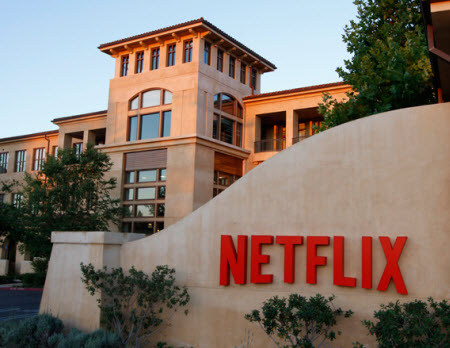May Price Hike Could Rain Pain on Netflix

A two-year grace period that shielded veteran Netflix subscribers from a 2014 price increase expires next month, an event some think could cause the subscription VOD pioneer to actually subtract customers during the second quarter of 2016.
The May switchover could be tricky: It’s the biggest price increase since 2011, when the company announced a rate hike for its streaming/mail-order DVD combination from $9.99 to $15.99 per month. Back them the backlash was swift — Netflix stock fell 40%, and customers called for Netflix CEO Reed Hastings to resign.
This time around, the company has been careful, buying itself time in the two-year wait for the initial outrage to wane. And analysts point out that customers intent on keeping the $7.99 price point can do so by dialing back their tier of service to the single-stream, standard- definition Basic Plan.
The pricing details: Netflix hiked the monthly fee for new customers in May 2014 to $9.99, but allowed existing customers at the time to remain at the previous $7.99 and $8.99 monthly rates for two years.
UBS media analyst Doug Mitchelson estimates about 17.8 million Netflix customers in the U.S. (37% of its total base) were at the $7.99 price point. He thinks the $2-permonth increase will be too high for between 3% and 4% of those customers, who will probably cancel service.
‘U.S. MATURITY FEARS’
Netflix is offering those grandfathered customers an opportunity to stay at the $7.99 rate, but they would have to downgrade service to one streaming device in standard definition, as opposed to two streaming devices in HD. While that could offset some of the cost-conscious churn, it isn’t expected to be much.
Multichannel Newsletter
The smarter way to stay on top of the multichannel video marketplace. Sign up below.
The churn from the grandfathered base amounts to about half of Netflix’s quarterly subscriber gains; in the fourth quarter it added about 1.5 million U.S. customers. Couple that with a maturing market — subscriber growth has softened in recent periods — and Netflix could be heading into its first negative streaming quarter ever.
“Investor concerns regarding the potential churn from such a large price increase are compounding the U.S. maturity fears already plaguing Netflix’s stock,” Mitchelson wrote. “Add in the fact that 2Q is the seasonally softest quarter, and some investors are even questioning whether Netflix will have its first quarter ever of declining U.S. streaming subscribers.”
In the past several quarters, Netflix has seen a steady softening of domestic subscriber additions, from 2.3 million adds in Q4 2013 to 1.5 million in Q4 2015. Most analysts who follow the company aren’t expecting the worst, but anticipate that the slower growth trend will continue.
Morgan Stanley media analyst Ben Swinburne revised his Q1 subscriber estimate downward to 1.8 million from 2.2 million after the SVOD pioneer missed his Q4 estimates.
“When you have as large of a subscriber base as Netflix, minor changes in churn can have a material effect on net subscriber additions,” Pivotal Research Group CEO and senior media & communications analyst Jeff Wlodarczak said. “I would be surprised if it goes negative even with negative 2Q seasonality, but you cannot completely rule it out. I figure they can do at least a couple hundred thousand.”
Mitchelson said in his report that the bear case for Netflix to lose subscribers in Q2 is unlikely, and he estimated the company would end the period with an increase of about 450,000 customers in the U.S.
Of the customers paying the old $7.99 monthly rate, Mitchelson estimated that 229,000 would churn off in Q2, with another 360,000 dropping the service in Q3.
Swinburne was a little less optimistic. He estimated that total additions would be about 150,000 and paid customer additions would be flat in the second quarter.
Fueling Mitchelson’s optimism is Netflix’s programming lineup. The company, the analyst wrote, has a strong original content slate with hit shows like Orange Is the New Black, Jessica Jones and Daredevil.
This year is expected to be especially strong — Netflix is increasing its original scripted series slate to 31 in 2016 from 16 in 2015 with shows like The Crown, Marvel’s Luke Cage, Frontier and The Ranch and has 10 feature films released or in production.
“We feel comfortable the slate supports our view for low levels of churn,” Mitchelson wrote in a report.
GROWTH MARKET: THE WORLD
While domestic growth is slowing, Netflix’s real opportunity is international, Mitchelson said. UBS estimates that the U.S., which represented 60% of total gross customer additions in 2014, will shrink to 38% by the end of 2016. Taking up the slack will be areas like Latin America, Europe and Australia.
Swinburne, also in a research note, figured international subscriber additions would rise to 3 million in the second quarter (from 2.4 million last year), with full-year additions at 15 million — 28% higher than the 11.75 million added in 2015 and outpacing his estimates for 4.1 million domestic additions in 2016.
Swinburne said he thinks international streaming customers will overtake their domestic counterparts in 2017, with 54.6 million subscribers (compared with 52.6 million domestically), reaching nearly 80 million customers by 2020. Domestic subscribers could reach 60 million in 2020 by his figures.
Wlodarczak added that, while international growth is important, so is stable U.S. growth, which validates Netflix’s increasing its original programming spend.
